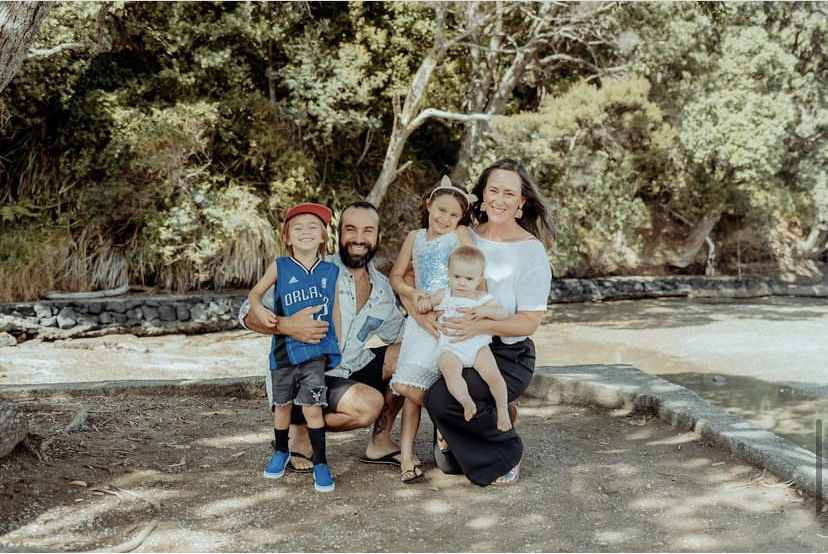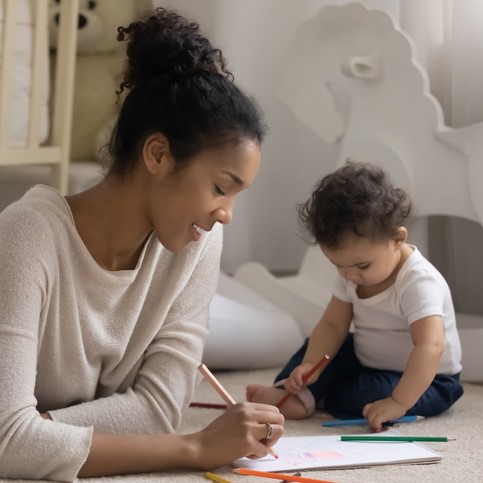Relaxed Birthing

To mark Home Birth Awareness Week, we spoke with mama of three, and a Relaxed Birthing practitioner Desiree Prendergast, about giving birth at home after two hospital births.
Kia ora Des,
Thank you for taking the time to kōrero with us! You have three beautiful tamariki, and your labours and births with each were all very different! Can you please talk us through each one?
Of course! My first birth began with a morning induction 10 days past Capri’s due date. Receiving a dose of induction gel I sat on a hospital bed wired up to machinery telling me I was experiencing regular labour sensations as my stomach tightened.
Hospital midwives prompted me to walk the stairs to let gravity help progress my labour, and after 12hrs of alternating walking and sitting I was sure we were going to have our baby that night. So when my Lead Maternity Carer (LMC) told me I was only 1cm dilated I felt deflated. I was told in the morning they would administer more gel. So my husband put on our favourite HypnoBirthing audio and we easily drifted off to sleep just as I had conditioned myself to do throughout the pregnancy.
An hour later I woke with what I call ‘actual’ contractions and vomited from the intensity. I had dilated to 2cm in that hour. I asked for an epidural – but I was too early – so I took a sleeping pill and codeine. On went the audio to re-establish calm and I drifted in and out of sleep, stirring every 15 mins with strong sensations. A few hours later, as I sat on the toilet trying to poo, I realised I was actually feeling the urge to push. The hospital midwife confirmed I was 9cm dilated, she broke my waters and I was ready to deliver.
I asked for an epidural – I was too late – so I used nitrous oxide gas to ease the intensity of my sensations. I initially tried to use HypnoBirthing techniques to ‘breathe baby down’, but my instincts took over and for an hour and a half I worked with my body during contractions to push and bear Capri down to crowning, calmly resting in between. Then when I felt like giving up, seemingly only moments later, Capri was in my arms. We were both fully alert and breastfeeding, I had a small labia tear, swelling and some heavy bleeding to recover from, but all that was secondary to the euphoria of holding Capri. In hindsight, I realise that when I actively relaxed my labour progressed smoothly.
My second birth began with a morning membrane sweep 10 days past Astro’s due date. I experienced some mild cramping throughout the day but carried on looking after almost 3 year old Capri. As we sat down to dinner in the early evening I realised that the sensations were coming pretty regularly. So I monitored them for an hour and found they were coming every 5 mins and lasting for a full minute. I spoke to my LMC to let her know I was in labour. Then I went to bed to listen to my own relaxed birthing audio recordings and easily drifted off to sleep.
A couple of hours later I woke with some indigestion but after some antacids I easily went back to sleep using the audio’s just as I had conditioned myself to do. At 10pm that night I awoke to my waters breaking, we made a few calls, waited for childcare to arrive, and then made our way into the hospital. At the point of moving around I felt some real discomfort around the intense and strong sensations I was experiencing, so I contemplated an epidural, but decided that what I was experiencing was intermittent and manageable.
At the hospital my LMC inspected me and advised I was 6cm dilated. On went the audio’s again as I tried to relax my body to neutralise the intensity of the sensations. But a few minutes later that instinctual urge to bear down overcame me and a mere 20 minutes later Astro was in my arms. No tears, no pain relief, no time to get in a birth tub (even though I actually imagined delivering in water for both Astro and Capri’s births). And while it was an uncomfortably intense birth due to the speed, as soon as it was over so was the discomfort. I was easily moving around, I felt incredibly relaxed and I was able to enjoy my new baby as he eagerly breastfed. While I’m still amazed at how different this labour felt to my first, once again actively relaxing really helped my labour progress and handle strong sensations.
During my third pregnancy we decided to try a home birth. In keeping with my history on 10 days overdue I saw my LMC for a membrane sweep, and by the evening my abdomen was tightening regularly. I spoke to my carer and went to bed listening to an audio, but when I woke all sensations had stopped. The next few days I tuned into every tightening with anticipation, but they were all mild enough to still move and talk.
I was recommended acupuncture to help initiate labour, so at both 11 and 13 days overdue I had treatment. After my second session, 14 days overdue, I had increasingly intense sensations and my LMC confirmed I was 3cm dilated. Wary that resting may stall my labour again, I kept walking until too uncomfortable, and made childcare arrangements.
By that afternoon my sensations were close (approx. 5mins apart) and increasingly stronger, so I went to bed listened to a relaxation audio and snoozed. An hour later a desire to have my midwife close overcame me, and as she arrived she suggested I try walk around a bit. I made it to the bathroom and felt like sitting on the toilet.
Shortly my team of three dedicated maternity carers, my husband and I were packed into my bathroom and my body started bearing down, but 30mins later Cleo just didn’t seem to be moving. With the help of my carers I tried different positions to get baby engaged, and situated on my back I felt some movement and decided I wanted to birth in the bedroom.
As I slowly moved my carer swayed my hips from side to side to get baby into a better position. After a period I felt I needed to rest and reclined on my bed, propped up against pillows with my legs bent against my carers. Cleo then slowly descended with each sensation and 30mins later she crowned, and we all found out she was facing up in a posterior position (which explained why it took the right position to get her around my pubic bone). Through my next surge and beyond I panted until baby fully emerged. Overwhelming relief engulfed me as Cleo was placed in my arms, I felt euphoric and powerful.
Each of my births were so different, and trying to plan exactly how they would unfold, and how I would want to react was guess work. In hindsight I realise that it was only when I actively relaxed, just as I had conditioned myself to do during pregnancy, my first two births progressed quickly and smoothly. However trusting my LMC and taking her advice to move around for my third birth was necessary to get baby in the right position. So I recommend adopting an open attitude with regards to all aspects – location, duration, pain relief, method of delivery etc. – to give yourself the best opportunity to feel and do whatever is right in the moment.
Since having children, you’ve become a Relaxed Birthing practitioner. Can you tell us a bit about Relaxed Birthing?
Relaxed Birthing is an affordable online antenatal course. Created because birth preparation classes should be realistic, accessible and affordable so that all couples can positively prepare for all birth outcomes, without over-preparing to the point of fear.
Relaxed Birthing concisely explains the most important aspects of birth; how your body works; how labour sensations may feel; labour insights (painstaking detail aside because your birth experience can differ drastically from someone else’s); plus why and how to discuss becoming a parent with your partner.
Why might a hapū māmā choose to follow the Relaxed Birthing principles?
Relaxed Birthing principles centre on preparing couples for a positive, yet realistic, birth experience. Because when you are armed with knowledge and encouraged to tune into your body and innate birthing ability you can give yourself the freedom to make decisions unencumbered by unrealistic expectations.
Another core value of Relaxed Birthing is to seek care from someone you trust and build encouraging support networks for pregnancy, birth and beyond. So you can have faith that if you happen to encounter difficulties at any point in your journey you won’t need to be a medical expert, a ‘good patient’, or be left to cope on your own, instead your trusted support network will help guide you through.
What are the benefits of Relaxed Birthing?
With about 250 babies born every minute globally it is safe to say women’s bodies were designed to birth babies. Relaxed Birthing explains how the labouring body works, helps you gain confidence in your innate birthing ability, and empowers you to effectively work with the energy of labour.
It also prepares your mind, which is equally as important as your body during birth, because when you feel scared or stressed during labour your body’s natural process can be thrown off track. With Relaxed Birthing you can positively prepare your mind and address any reservations you may have.
Relaxed Birthing teaches relaxation skills to allow the natural process of birth to unfold at its own unique pace. Which can be incredibly beneficial in the early stages of labour and can support you through any intense sensations or challenging moments.
Relaxed Birthing also explains simple techniques to breathe correctly throughout labour and life. Because proper breathing provides life-giving oxygen, conserves energy, promotes relaxation, maximises the effect of labour contractions, and assists the natural bearing down pulsations of your body.
Can you use Relaxed Birthing if you have a hospital birth too?
Absolutely! Relaxed birthing techniques can be used in any kind of birth experience – natural unassisted childbirth, assisted childbirth, delivery by caesarean surgery (C-section), at home, in a birth centre, or in a hospital etc.
The aim of Relaxed Birthing is to help you understand how your body works, place trust in your caregivers to be the medical professionals, and feel empowered to make decisions before, during and after labour that are right for you.



